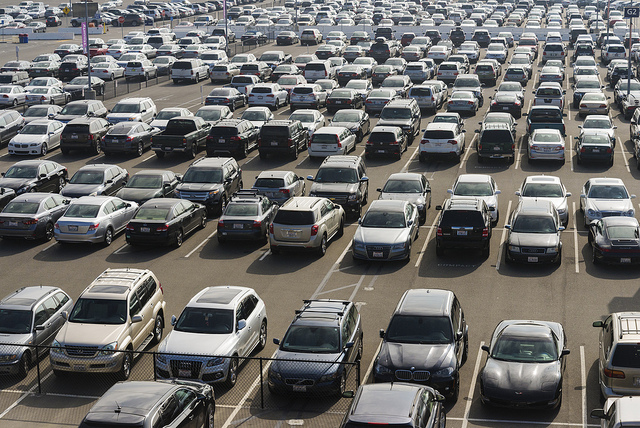By Julia Foote
 It can be as simple as two lines painted on asphalt. But the humble parking space has much more to do with climate action than one may think. Of course there are better known environmental impacts of paved surfaces, such as exacerbated heat island effects, increased stormwater runoff, and degraded water quality; but when it comes to creating successful transit-oriented development — the key to “smart growth” — parking is a crucial planning element.
It can be as simple as two lines painted on asphalt. But the humble parking space has much more to do with climate action than one may think. Of course there are better known environmental impacts of paved surfaces, such as exacerbated heat island effects, increased stormwater runoff, and degraded water quality; but when it comes to creating successful transit-oriented development — the key to “smart growth” — parking is a crucial planning element.
Parking is a tricky element to consider because it can be contradictory to the goals of transit-oriented development. Residents of transit rich areas are twice as likely not to own a car compared to other U.S. households, and two to five times more likely to commute by transit. Providing parking within a mixed-use, transit-oriented community can serve as an enabler for people to use a vehicle to get around to places they could otherwise access by foot, bike, or public transit.
Providing parking for a residential development can make it more appealing for someone to own a car if the spot is coupled with their unit. In fact, excess residential parking is tied to higher rates of automobile ownership, vehicle miles traveled, and traffic congestion. Parking tends to increase housing costs as well, and it also results in lost development opportunity because space and funds could have been used for residential units, commercial development, or public space.
Of course people opting to take BART for part of their commute is conducive to goals of reducing emissions. However, massive parking projects are costly; they consume land and resources needed for dense, mixed-use development in a region facing a housing shortage; and they take away from the walkability and vibrancy that transit-oriented communities should possess.
We’re used to seeing parking as an ordinary feature of the urban landscape, in lots, garages, and all along our streets. But it’s time to reimagine our cities. We must shift our focus away from fulfilling the extreme demand for parking and towards improved transit connections, bike lanes, and pedestrian connectors. Changing the way our cities are designed will change residents’ behavior — hopefully creating more sustainable habits.
Parking is on people’s minds all throughout the Bay Area. The kickoff of the Walnut Creek Transit Village features a $42-million parking garage with over 900 parking stalls — an excessive number for just 596 housing units located just steps from BART. The new Antioch BART station now has a proposed $16.4-million parking lot that will include more than 800 new parking spaces, nearly doubling parking capacity at the station. That lot will take up space that could be put to better use for transit-oriented development, and will eat up resources that could otherwise improve BART access by bike, by foot, and by transit. With BART planning to add 20,000 housing units at its stations by 2040 — including on current parking lots — the parking issue is sure to remain hotly contested.
Cities must balance the demand for parking with an enhanced transportation network and other strategies to support green mobility. Of course, parking is an accessibility issue, and should be provided and prioritized for those with mobility impairments who need a vehicle to get around.
The Sierra Club recommends:
- Reducing parking requirements and eliminating parking subsidies;
- Greatly reducing or eliminating parking in areas served well by public transit;
- Unbundling parking charges from rents;
- Limiting or raising the cost of parking in business, commercial and industrial centers in order to encourage transit use, walking, and alternative modes such as bikes and scooters;
- Providing station access by foot, bicycle and public transit, with minimal, but full-priced, public parking;
- Encouraging compact mixed-use land use patterns that prioritize walking and biking over vehicles; and
- Building and supporting public transit.
Julia Foote is a staff organizer at the Bay Chapter
Photo by Sergio Ruiz.